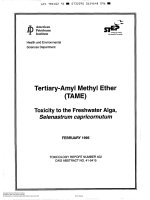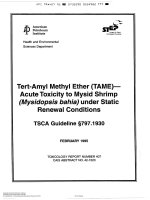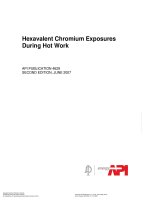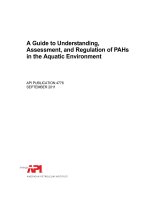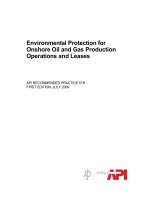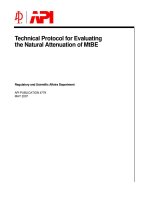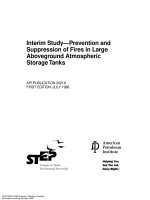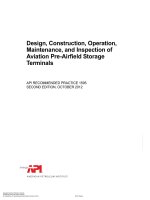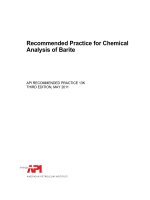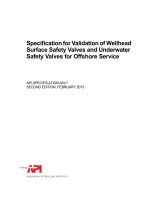Api publ 4772 2008 (american petroleum institute)
Bạn đang xem bản rút gọn của tài liệu. Xem và tải ngay bản đầy đủ của tài liệu tại đây (913.45 KB, 38 trang )
Measuring Particulate Emissions
from Combustion Sources
API PUBLICATION 4772
SEPTEMBER 2008
Measuring Particulate Emissions
from Combustion Sources
Regulatory and Scientific Affairs Department
API PUBLICATION 4772
SEPTEMBER 2008
Special Notes
API publications necessarily address problems of a general nature. With respect to particular circumstances, local,
state, and federal laws and regulations should be reviewed.
Neither API nor any of API's employees, subcontractors, consultants, committees, or other assignees make any
warranty or representation, either express or implied, with respect to the accuracy, completeness, or usefulness of
the information contained herein, or assume any liability or responsibility for any use, or the results of such use, of any
information or process disclosed in this publication. Neither API nor any of API's employees, subcontractors,
consultants, or other assignees represent that use of this publication would not infringe upon privately owned rights.
API publications may be used by anyone desiring to do so. Every effort has been made by the Institute to assure the
accuracy and reliability of the data contained in them; however, the Institute makes no representation, warranty, or
guarantee in connection with this publication and hereby expressly disclaims any liability or responsibility for loss or
damage resulting from its use or for the violation of any authorities having jurisdiction with which this publication may
conflict.
API publications are published to facilitate the broad availability of proven, sound engineering and operating
practices. These publications are not intended to obviate the need for applying sound engineering judgment
regarding when and where these publications should be utilized. The formulation and publication of API publications
is not intended in any way to inhibit anyone from using any other practices.
Any manufacturer marking equipment or materials in conformance with the marking requirements of an API standard
is solely responsible for complying with all the applicable requirements of that standard. API does not represent,
warrant, or guarantee that such products do in fact conform to the applicable API standard.
All rights reserved. No part of this work may be reproduced, stored in a retrieval system, or transmitted by any means, electronic,
mechanical, photocopying, recording, or otherwise, without prior written permission from the publisher. Contact the Publisher, API
Publishing Services, 1220 L Street, N.W., Washington, D.C. 20005.
Copyright © 2007 American Petroleum Institute
Foreword
Nothing contained in any API Publication is to be construed as granting any right, by implication or otherwise, for the
manufacture, sale, or use of any method, apparatus, or product covered by letters patent. Neither should anything
contained in the publication be construed as insuring anyone against liability for infringement of letters patent.
Suggested revisions are invited and should be submitted to the Director of Regulatory and Scientific Affairs, API,
1220 L Street, NW, Washington D.C. 20005.
Table of Contents
Section
Page
Executive Summary………………………………………………………………………….. 1
Introduction: Filterable and Condensable Particulate Emissions……………………………. 4
Principal Measurement Approaches…………………………………………………………. 4
Filter/Impinger System: Directly Sampling Stack Gas……………………………….4
Dilution Sampling System: Replicating Ambient Air……………………………….. 5
Condensable Particulate Formation………………………………………………………….. 5
Conventional Measurements: Filter/Impinger Sampling……………………………………. 6
EPA Method 5……………………………………………………………………….. 6
EPA Methods 5B and 5F…………………………………………………………….. 7
EPA Method 17……………………………………………………………………….8
EPA Method 201A……………………………………………………………………8
Sulfuric Acid Emission Measurements……………………………………………………… 9
EPA Methods 6 and 8……………………………………………………………….. 9
Controlled Condensation System……………………………………………………. 10
Importance of Measuring PM 2.5 and Condensable Emissions……………………………... 11
EPA Method 202 and its Modifications………………………………………………12
South Coast Air Quality Management District Methods 5.1 and 5.2……………………….. 14
An Alternate Approach: Replicating the Atmosphere with Dilution System Sampling…….. 14
Dilution System Sampling Results………………………………….……………………….. 17
Mass Emissions……………………………………………………………………… 18
Chemical Speciation…………………………………………………………………. 18
Quantitation and Precision…………………………………………………………………… 20
Guidance for Source Operators: Which Method Do I Use and When? ……………………... 20
References……………………………………………………………………………………. 24
Executive Summary
The principal measurement methods for sampling particulate matter (PM) from stationary
combustion sources generally consist of a sampling train that includes a heated filter
maintained at a variety of elevated temperatures, followed by a series of aqueous impinger
solutions used to collect material that is in the vapor phase within the stack, but could condense
and form PM immediately after entering the atmosphere. These two fractions are commonly
referred to as “filterable” (e.g. fly ash or catalyst fines) and “condensable” (e.g. sulfuric acid,
semi-volatile organics, or ammonium sulfates), PM. Since the early 1970s, the EPA has
proposed a number of methods to determine PM emitted from combustion sources and these
are discussed in this report. Most of the attention was initially centered on measuring filterable
PM as this material was considered to comprise the major fraction of PM emissions subject to
removal by control technology.
The EPA methods and their variants differ primarily in the temperature of the collecting filter,
leading to accumulation of different amounts of material on the filter (depending upon the
species present in the stack gas). A summary of the operating temperatures and impact on
condensables accumulation (Table 1) indicates the biases that can occur between the principal
PM measurement methods employed today.
Table 1. PM Emissions Measurement Methods & Filter Temperatures: Will the
Component Be Collected on the Filter?
Method
Filter
Temperature, oF
Catalyst
Fines/Ash
H2SO4
NH4 Sulfates
EPA 5
248 ± 25
Yes
Some
Yes
EPA 5B, 5F
320 ± 10
Yes
No
Yes
EPA 17
Stack temp.
Yes
No*
No*
EPA OTM 27
Stack temp.
Yes
No*
No*
SCAQMD 5.1/5.2
190
Yes
Some
Yes
Dilution Sampler
Ambient
Yes
Yes
Yes
*Stack temperatures are generally > 500 oF for units without wet scrubbers. Units equipped
with wet scrubbers have stack temperatures < 200 oF and are likely to collect some H2SO4 and
all NH4 sulfates.
SCAQMD refers to the South Coast Air Quality Management District.
1
2
API Publication 4772
After the introduction of the National Ambient Air Quality Standards (NAAQS) for fine
particulate matter, regulatory interest shifted to methods that also measured the condensable
fraction (consisting of PM having aerodynamic diameters equal to and less than 2.5 microns).
Accurate measurements of these emissions became important as regulators sought to ensure
attainment of PM ambient air quality standards by controlling source emissions. This paper
discusses the technical basis of the resulting biases for both filterable and condensable PM for
the various test methods
The American Petroleum Institute recognized the importance of this issue in 1997, initiating a
review of the appropriate test method before undertaking a comparative testing program for
PM 2.5 emissions from refinery sources. Measurements were made using a conventional
cyclone/filter/impinger method (EPA Methods 201A and 202) along with a newly developed
dilution system sampler. This new sampler seeks to represent atmospheric conditions by
diluting and mixing stack gas with clean ambient air, and collecting the resulting PM on filters
similar to those used in ambient air sampling. Initial results from this program showed the
cyclone/filter/impinger method had a significant positive bias that overstated the emissions of
condensable PM because some of the stack gas SO2 was converted to sulfate PM in the
impinger solutions. This program was expanded in 2000 with the participation of several other
organizations: US Department of Energy, Gas Research Institute, California Energy
Commission and the New York State Energy Research and Development Authority. By the
conclusion of the test program in 2004, the emissions of over a dozen combustion units had
been measured. These studies confirmed the initial findings and demonstrated that the dilution
system method provided more accurate and reproducible emissions data than those from
filter/impinger methods.
In addition to providing more accurate PM emissions data, the dilution system readily provides
a means of chemically characterizing these emissions in terms of their metals and organic
content. Emissions from gas-fired sources were found to be significantly lower than those
obtained using conventional test methods. The particulate matter collected was found to
consist mainly of semi-volatile organics with no significant contribution from any poly-nuclear
aromatics or metals. Emissions from catalytic cracking units were dominated by catalyst fines
with their characteristic metals content, sulfuric acid, and to a lesser degree semi-volatile
organics.
While dilution system sampling has been endorsed by a committee of the National Research
Council and the EPA, the sampling devices are not widely available at present. In the interim, a
series of alternative options are provided as guidance to refinery source operators. These
recommendations are:
•
Use EPA Method 202 cautiously; it has a serious problem with positive bias caused by SO2 to
sulfate conversion. While the EPA recognizes this, it is not clear that all state and local
regulatory agencies do. Therefore, it is important to ensure that these agencies are also aware
of the deficiencies of this method when used for compliance testing.
• The EPA has accepted a revised version of Method 202 to minimize the formation of
artifact sulfate that appears promising. However, it has not been extensively field tested
Measuring Particulate Emissions from Combustion Sources
•
•
3
and the presence of NH3 in combustion emissions may lead to a positive measurement
bias
PM emissions from gas-fired process heaters, boiler, and IC engines can adequately be
determined by a method that only collects the filterable PM. This is supported by
extensive testing, which shows that the condensable fraction for these sources is
negligible.
PM emissions from catalytic cracking units are probably best treated on an individual
basis as their operating characteristics differ widely, leading to a range of combustion
gas compositions. API studies have shown that emissions of semi-volatile organics are
only a minor component compared to catalyst fines and condensable sulfur species
(e.g., sulfuric acid and sulfate salts). Consequently a prudent approach to measuring
these PM emissions is to focus on the major species using a combination of EPA
Method 17 and the controlled condensation sampling system.
4
API Publication 4772
Introduction: Filterable and Condensable Particulate Emissions
Since the inception of the Clean Air Act, the petroleum refining industry has been faced with
the need to determine criteria pollutant emissions from combustion sources. While some of
these species, such as NOx, SO2 and CO remain in the vapor phase during and after
combustion and are relatively simple to measure, particulate matter (PM) measurements are
much more challenging. This is because while some PM such as fly ash or catalytic cracking
catalyst fines is clearly solid material that is readily collected and measured on a sampling
filter, other species that may exist in the vapor phase during combustion can later condense
into aerosols downstream from the combustion zone. This can occur before or after any
control devices, depending upon the temperature and composition of the combustion gases.
Consequently, it has been customary to refer to PM as being composed of two PM
components, filterable and condensable, the relative amounts of each depending on the stack
gas composition and temperature, control devices in use at the unit, and the method for
measuring PM. While measuring filterable PM is relatively straightforward (i.e., PM collected
on a filter), condensable PM is a more esoteric quantity and its contribution to total PM
emissions is very much dependent upon the choice of the measurement method. The EPA
apparently recognized this issue, and until the interest in measuring and controlling PM 2.5
emissions emerged in the 1990s, their PM sampling methods were centered on measuring only
filterable PM (Myers, 2006). At the time that these methods were originally instituted, the best
available pollution control devices were mainly limited to filterable PM and could not control
the condensable portion of PM emissions (Federal Register, 1975). As interest in the health
effects associated with PM emissions increased, efforts were centered on determining the
contribution of the PM 2.5 fraction which was believed to most responsible for these effects
and principally composed of condensable matter (Federal Register, 1991). This report will
review the conditions leading to the formation of condensable particulate matter from stack gas
components along with the methods used to measure PM emissions from refinery combustion
sources.
Principal Measurement Approaches
Filter/Impinger System: Directly Sampling Stack Gas
Historically the EPA has promulgated a series of sampling methods based on a combination of
filters and aqueous impingers to collect the filterable and condensable PM present in stack
emissions. While these methods are somewhat complex and cumbersome compared to those
used to measure gas phase species like SO2, sampling equipment for them is now available
from a number of suppliers and the commercial stack testing community is very familiar with
their use. From the outset, a number of questions remained about this approach: was an iced
water bath an appropriate medium to collect species present as vapors in the stack gas that
would later cool and condense at atmospheric temperatures, and could reactions within the
impinger solution or during the subsequent analytical procedure lead to the formation of
artifact PM?
Measuring Particulate Emissions from Combustion Sources
5
Dilution Sampling System: Replicating Ambient Air
An alternate approach is to develop a method that attempts to replicate the physical conditions
that occur in the atmosphere once the flue gases are emitted form the stack. Organic and
inorganic vapors in a defined state of equilibrium at stack conditions (i.e., temperature,
pressure, moisture level, concentration) will now cool and dilute in the sampling system to a
new state of equilibrium representative of atmospheric conditions. For most combustion
sources the change in temperature that occurs between stack and atmospheric conditions may
be the most significant factor impacting the formation of secondary PM. This reduction in
temperature not only allows the vapors to condense, but also allows reactions to occur that
were inhibited at higher stack temperatures. Since the early 1970s, mobile source emissions
have been quantified using a dilution tunnel sampling system that replicates atmospheric
formation conditions (Federal Register, 1971). Small volumes of exhaust gas are cooled with
10-40 times their volume of cool air in a dilution tunnel. In addition to cooling the sample gas,
the dilution air prevents the condensation of water, as the air absorbs moisture that would
otherwise condense. After cooling, a short delay or residence time is allowed prior to sample
collection.
While several of these dilution system samplers were developed in the 1970s and 1980s for
research purposes, their size, weight, and bulk were a detriment for use at stationary sources
that required rapid assembly in often elevated and cramped locations. However, recent
technological advances resulted in a simplified design for these samplers, and led the API to
sponsor an extensive series of tests using them at a number of gas-fired sources and fluid
catalyst cracking units (FCCUs) from 1998 to 2004 (England, 2005, 2007, 2007). These tests
were carried out simultaneously with measurements made using conventional PM stack
sampling methods and provide a good comparison of the two approaches.
Condensable Particulate Formation
The methods developed by the EPA and other agencies to measure the condensable fraction of
PM are designed to collect both organic and inorganic components. However, emissions of
condensable organics are generally encountered only during manufacturing operations such as
spray painting. Refinery combustion sources have extremely high combustion efficiencies, low
stack gas CO concentrations, and typically contain extremely low levels of condensable
organics (England, 2005). Emissions of filterable PM are associated with a wide range of
particle size diameters, having a significant fraction greater than 2.5 microns in diameter, while
condensable PM is formed at aerodynamic diameters equal to or less than 2.5 microns.
Condensable particulates that are typically emitted from refinery combustion sources are
present in the vapor phase during combustion as SO3, SO2, and NH3 and later condense at
lower temperatures in the presence of water vapor as sulfuric acid or ammonium sulfates. The
relative amounts of the sulfur oxides present depends on the sulfur content of the fuel, the
oxygen levels, and the presence of any trace metal catalysts that convert SO2 to SO3. In the
6
API Publication 4772
presence of water vapor SO3 reacts to form H2SO4, which can then condense as an aerosol or
on the surfaces of fine particulate matter when the temperature drops below its dew point. The
increasing use of NH3 for NOx control adds another degree of complexity, as any ammonia slip
can react with the SO2 or SO3, and water vapor to form condensed ammonium sulfates at
temperatures from 350 - 450 oF (depending upon the concentrations of SO2, SO3, NH3, and
H2O). The conditions leading to the formation and condensation of these sulfates were
extensively analyzed (Burke, 1982). At that time, the main concern was formation of corrosive
sulfate and bisulfate deposits in air preheaters caused by NH3 injection to reduce NOx
emissions from the upstream combustion unit. However, the analysis and conclusions from the
Burke study are equally applicable to the present discussion of PM emissions measurement
techniques.
Sampling trains that use aqueous impinger solutions after the PM filter to collect condensable
PM have shown a positive bias in condensable results due to the conversion of SO2 to SO3
across the impingers at a rate that is higher than typically occurs in the atmosphere near the
source. Furthermore, the conditions present in the impingers are not representative of those
found either in the stack or in the atmosphere. Consequently, it is not surprising that the
amount of PM measured from these sources varies widely, depending upon the measurement
method used.
Conventional Measurement Methods: Filter/Impinger Sampling
In response to the needs of the New Source Performance Standards (NSPS) limiting emissions
of criteria pollutants, the EPA has developed over a period of time a number of methods to
measure PM emissions from a variety of sources. Of these, the following are of particular
interest to the refining industry.
EPA Method 5
The initial source test method developed by the EPA, Method 5, dates back to 1971 shortly
after the inception of the first group of NSPS (Federal Register, 1971). Method 5 uses a
sampling probe together with a pitot tube to isokinetically traverse and sample the stack at a
series of points to collect PM samples for a minimum of 1 hour period on an external glass
fiber filter maintained at 120 ± 14 oC or 248 ± 25 oF (Figure 1).
Isokinetic sampling conditions are satisfied when the PM probe sampling velocity is adjusted
to equal the stack gas velocity at the sample point. This ensures that the stack traverse
provides a representative sample encompassing the full range of PM sizes present in the stack.
A compliance test on a process unit is defined as consisting of three test runs meeting the
conditions of the method that are carried out during constant representative unit operating
conditions. Method 5 only quantifies filterable PM, as somewhat arbitrarily defined by a
collection temperature of 248 ± 25 oF, and did not directly address the measurement of
condensable PM. This was primarily due to the fact that the best available control devices of
that time were not able to reduce the condensable portion of the emissions. Consequently, a test
method that included collection of any condensable fraction would not directly characterize the
Measuring Particulate Emissions from Combustion Sources
7
performance capabilities of existing air pollution control equipment. A complete description of
this method along with all the other EPA methods mentioned here can be found on the EPA
website www.epa.gov under “Methods”.
Figure 1. EPA Method 5 Sampling Train (U.S. EPA, 2000)
EPA Methods 5B and 5F
Quantifying only the filterable component of PM shifted the focus from atmospheric emissions
to characterizing the performance characteristics of pollution control equipment. Several
subsequent NSPS publications included source categories with significantly different source
characteristics and control devices. Thus, FCCUs were recognized as a special category having
the potential for sulfuric acid emissions that could not be controlled by then available PM
control technology, dry electrostatic precipitators (ESP) or cyclone separators. To measure the
effectiveness of these devices, Methods 5B and 5F were developed. These are similar to
Method 5 except that the filter temperature is now at 160 + 5oC or 320 + 10 oF, ensuring that
no sulfuric acid would condense on the filter. The methods are essentially identical in practice
and differ only in the analytical procedures used to determine the amount of condensable
8
API Publication 4772
ammonium sulfate PM that may have been collected on the filter. This amount is then
subtracted from the total filterable PM measurement to obtain a filterable PM for reporting.
The temperature range for the formation of these sulfates shows that their formation depends
on the stack gas composition (Burke, 1982). Assuming an SO3/SO2 fraction of 0.02 and SO2
and NH3 stack levels of 200 ppm and 20 ppm, respectively, sulfate condensation occurs at
about 410 oF. For lower SO2 concentrations, 10 ppm, and the same ammonia level, the
condensation temperature drops to 350 oF. Consequently, EPA Methods 5B and 5F are
expected to collect the condensable ammonium sulfates because the filter temperature used in
these methods usually is below the ammonium sulfate dew point.
EPA Method 17
In another attempt to develop a method that directly determines filterable PM, Method 17 was
introduced in the 1980s. This method is similar to the Methods 5B and 5F except for the filter
location. While Methods 5B and 5F use a filter external to the stack, Method 17 uses an instack glass or quartz fiber filter to directly measure PM inside the unit (Figure 2).
Figure 2. EPA Method 17 Sampling Train (U.S. EPA, 2000)
Measuring Particulate Emissions from Combustion Sources
9
Stack gas temperatures for process heaters and FCCU’s are usually about 500 oF, which is
above the sulfuric acid dew point. The sulfuric acid dew point in these systems depends upon
the concentrations of water vapor and H2SO4, and can vary from 240 oF to 280 oF over a range
of 1-10 ppm H2SO4 and 12-15% moisture content (Lundgren, 1978, Abel, 1946). These high
stack temperatures are also above the formation temperatures for NH4HSO4 and (NH4)2 SO4
(350-400 oF), so that in cases where ammonia is present, condensable species will not be
collected. However, if the unit is equipped with a wet scrubber or an ESP and has a sampling
temperature below 200 oF, all the ammonium sulfates and sulfuric acid would be collected on
the filter. Consequently it is not surprising that PM emission results from the same unit could
vary significantly, depending upon the measurement method used, the presence or absence of
condensable sulfates, and the temperature of the sampling filter.
Sulfuric Acid Emissions Measurements
Although the EPA did not require measurement of condensable PM prior to the development
of the fine particle standard for ambient air, it was aware of the health effects of sulfuric acid
aerosols. As such, the EPA recognized the need to have methods available to measure the
condensable PM emissions from stationary combustion sources that burn sulfur-containing
fuel. The principal SOx species emitted by these sources is SO2; further conversion to SO3
depends upon the fuel being burned, the amount of excess air used during combustion, and the
type of combustion source. For refinery-gas fired heaters, SO3 levels are typically less than 1%
of the SO2 present, but they can range up to 5% of SO2 for FCCUs depending upon the metals
levels in the crude being processed. For most stack gas compositions, the relatively large
amounts of water vapor present (10-15%) will result in virtually all these S(VI) species being
emitted as sulfuric acid (Lundgren, 1978). To attempt to measure these emissions, the EPA
developed Methods 6 and 8, which are both impinger-based methods. These methods differ
slightly in impinger design, but both are intended to collect SO3/sulfuric acid as well as SO2.
EPA Methods 6 and 8
In these methods, an initial impinger consisting of an 80% isopropyl alcohol (IPA) solution in
water is followed by two additional impingers containing 3% aqueous hydrogen peroxide
solutions. Any SO3 or sulfuric acid present in the stack gas is captured in the IPA impinger and
the SO2 is then oxidized to sulfate and collected by the peroxide solutions. While these
methods have generally worked well for most purposes, they have been troubled by the
residual solubility of SO2 in the IPA impinger solutions that can result in a positive bias when
measuring low emissions levels of sulfuric acid. This problem becomes greater when NH3 is
also present in the stack, and laboratory studies have shown that NH3 contributes an additional
positive bias to sulfuric acid measurement using these methods (England, 2008)
10
API Publication 4772
Controlled Condensation System
The problems with Methods 6 and 8 led to the development of a new method for sampling
SO3/sulfuric acid concentrations, the controlled condensation method (Figure 3).
In this method, an in-stack filter (> 500 oF) precedes a cooled condensation coil that lowers the
filtered sample gas temperature to 167-185 oF, below the dew point of sulfuric acid. Droplets
of condensed sulfuric acid are collected and rinsed from the coil while the SO2 passes on and is
collected in peroxide solution impingers. There are several published variations of the method,
differing in the filter temperature and sulfate analysis procedures employed (Maddalone, 1979,
Cheney, 1984). In contrast to the bias found for Method 8, the additional presence of ammonia
in the sample stream does not contribute a positive bias to the sulfuric acid measurements using
this method (England, 2008). This method has not been widely used for refinery source testing
despite the fact that the EPA recognizes controlled condensation as a valid test method (Myers,
2007) and provides the method as NCASI Method 8A in the list of Conditional Test Methods
provided in the EMC section of the EPA website (www.epa.gov/ttn/EMC). As such, operators
of refinery combustion units are encouraged to insist that regulatory agencies accept it for
testing inasmuch as the current EPA Methods 6 and 8 are subject to a positive bias and not
sufficiently accurate at low SO2 concentrations.
Figure 3. Controlled Condensation Method Sampling Train (SO3) (Maddalone, 1979)
Measuring Particulate Emissions from Combustion Sources
11
Importance of Measuring PM 2.5 Emissions and Condensable PM
The EPA’s increasing concern about the health effects of inhaling PM ultimately led to the
development of new National Ambient Air Quality Standards (NAAQS) for fine PM, defined
as having an aerodynamic diameter equal to or less than 2.5 microns equal to or less than 2.5
microns as measured by EPA Reference Methods (Federal Register, 1997). This occurred
along with the development of new emission sampling methods, Methods 201 and 201A that
included in-stack cyclones ahead of an in-stack filter (Figure 4) to quantify different PM size
fractions: total PM, PM 10 and PM 2.5. These methods were designated as Conditional Test
Method 40 (CTM 040) and, more recently, as Other Test Method 027 (OTM 027).
At the same time, advances in emissions control technology resulted in the development of
improved wet scrubbers and wet ESPs capable of capturing fine PM. The PM 2.5 fraction of
the total PM emissions had a large component of condensable PM, as the physics of
condensation leads to the formation of small-size particles. Consequently, the EPA
reconsidered methods for determining condensable PM and returned to their original proposal
for Method 5, including aqueous impingers after the heated filter to collect the condensable
PM. With the promulgation of this method, the EPA believed that it had procedures to quantify
the emissions of condensable PM and filterable PM into the atmosphere, as well as the means
to determine the effectiveness of control technologies designed to reduce them (Myers, 2006).
12
API Publication 4772
Figure 4. EPA OTM 027 Sampling Train (U.S. EPA, 2004)
EPA Method 202 and its Modifications
The method promulgated by the EPA for measuring condensables was published as
Method 202. Method 202 measures condensable PM by bubbling a pre-filtered gas sample
through a series of impingers partially filled with water and placed in an ice bath. The impinger
solutions are then evaporated and dried to determine the net residue weight. The method
includes a number of blanks (de-ionized water, dichloromethane, and a filter) used to correct
the test results. In an attempt to correct some of the difficulties present in the original draft first
proposed in 1971, the new method included a nitrogen purge of the impingers after completion
of the test to remove any residual SO2 from solution to prevent its conversion to sulfate. The
inclusion of a different solvent, dichloromethane, was also thought to result in improved
extraction of any organic condensable PM present. In the years following its publication, this
method was widely adopted by state and local regulatory agencies for compliance testing to
measure condensable PM in a sampling train along with filterable PM, thereby determining
total PM emissions. However, it soon became apparent that measurements of condensable PM
made with Method 202 were higher than anticipated for gas-fired sources, and its accuracy
was questioned (Corio, 2000). Evidence grew that the nitrogen purge was very important but
not effective in preventing conversion of dissolved SO2 to condensed sulfates, which
subsequently could react with dissolved ammonia to form ammonium sulfates prior to actual
analysis. In addition, any NH3 in the emissions gas, either as a consequence of its use as a
